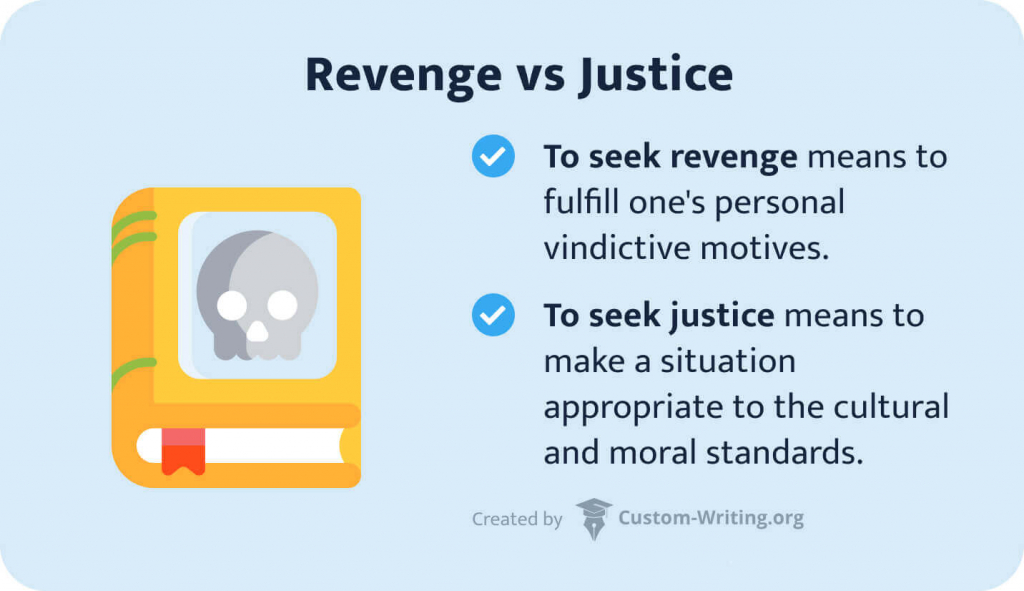The theme of revenge is often presented in literature as a driving force for characters and plot. Although initially, we might perceive it as a human desire for justice, there are way more complex psychological and moral issues. According to Daniel Hack’s article published in Victorian Studies, while revenge is a plan and action that unfolds in the future, it is also a “direct product of and response to events in the past.”
Some characters constantly seek revenge to get relief but is it really the only way for them to find peace? Or is it just a mirror of a personal pain? By examining these questions, the literature reveals that revenge is not a solution but an allegory for the complexities of human emotions.
In this article by Custom-Writing.org, discover:
- The meaning of revenge in literature
- Analysis of revenge themes in Hamlet, Wuthering Heights, and Frankenstein
- Inspiring revenge essay topics
⚔️ Revenge Theme: Meaning
Revenge is a response to injustice. To be more precise, it is both a desire and an action of a person who wants to react to a wrong done by the offender. Seeking revenge is a natural impulse of the wounded.
Usually, people want to do it in order to get satisfaction. However, the result will be temporary. Psychologists believe that only forgiveness can provide freedom and the desired peace. Nevertheless, revenge remains an enduring concept in many cultures.
In the English language, various terms denote revenge as well as other closely related notions. We are going to deal with them in the following sections.
Avenge vs Revenge
The major difference between “to avenge” and “to revenge” lies in the inflicted party:
- If one wants to pay back for someone who was offended, we use “to avenge.”
- If a person wants to pay back for themselves, we use “to revenge.”
Vengeance vs Revenge
The main difference between vengeance and revenge is that revenge refers to personal action, while vengeance is connected with abstract concepts such as morality.
- When a person seeks revenge, they want to punish the transgressor.
- When they seek vengeance, they want to achieve justice or to protect their honor.
Revenge vs Justice
The difference between revenge and justice is that justice as a concept is logical and rational, while an act of revenge is selfish and emotional.

Digging deeper, we can say that justice is fair, while revenge isn’t. Usually, when people confuse these two notions, they think that revenge will help them seek justice. However, justice isn’t about equality, and it’s not about experiencing joy because of retaliation. Instead, it’s about acting according to the norms set by the majority.
According to American Psychological Association, revenge is often associated with the concept of emotional catharsis. It means that a person can get an enormous emotional burst after the act of vengeance. It evokes pleasure when a person sees the offender’s suffering. However, this satisfaction is fleeting, and those who take revenge end up feeling even worse.
Revenge is mainly associated with anger, hatred, and grief. That’s why the theme of revenge is so prevalent in art and literature. It allows authors to show the feelings people experience before, during, and after an act of vengeance. Most of the works demonstrate that revenge isn’t worth spending time and effort because it doesn’t provide relief.
🎭 Revenge in Literature: History & Characteristics
The revenge theme has always been popular, and it goes back to ancient times. It’s hard to find a person who doesn’t know the story about brothers Cain and Abel described in the Bible. Also, the topic of revenge was explored in epic poems such as The Iliad and Beowulf. This theme became especially popular in the form of revenge tragedy during the Renaissance.
Revenge Tragedy: Definition
A revenge tragedy is a type of dramatic writing in which a person tries to pay back for the moral or physical harm done to their loved ones. Usually, the protagonists seek revenge because they believe in retributive justice—a concept which, according to Encyclopedia Britannica, is based on the principle “an eye for an eye.”
Revenge tragedies date back to the times of Ancient Rome. The theme of revenge was one of the central issues in the works of a famous Stoic philosopher and politician, Seneca. He described shocking actions, such as incest, violent murders, or cannibalism. In plays such as Oedipus and Agamemnon, revenge is the central theme. So, it’s possible to say that Seneca invented the notion of a revenge tragedy.
But why was revenge tragedy so popular during the Renaissance? The matter is that Senecan tragedies were of significant interest to the writers of that time because of all the terrific plot twists. Jacobean audiences especially adored the bloody scenes. Roman plays were translated into English, and they served as an example for English playwrights.
William Shakespeare, an outstanding representative of Elizabethan drama, used many Senecan motifs in his plays. However, the major difference between the approaches of these two playwrights is the description of bloodshed. In Senecan tragedies, all the bloody scenes occurred offstage, while in Shakespearean plays, they happened onstage. That’s why the audiences who came to Shakespeare’s theater always knew they’d get to see a thrilling spectacle.
Revenge Tragedy Characteristics
We have already explained the historical side of revenge tragedies. Now, let’s deal with their core aspects. Here are the elements that characterize this kind of writing:
Revenge Theme’s Elements
Just like revenge itself, the theme of revenge is a complicated thing. Its components include specific character motivations and consequences of revenge. Want to learn more about these aspects? Read the following sections.
Plotting Revenge
Taking revenge is usually a lengthy process. An avenger needs to plan everything carefully to carry out their vengeance in the most satisfying way. The proverb “revenge is a dish best served cold” sums up the whole process perfectly.
Cycle of Revenge
The revenge cycle is a continuous repetition of a person’s attempts to avenge themselves or their loved ones. An avenger focuses on the idea of paying back and continuously tries to realize it. Usually, this vicious circle can be broken only with the help of forgiveness.
The Price of Revenge
Avengers tend to pay a high price for their vindictive actions. Revenge is a morally dubious act that causes pangs of consciousness. A person may lose their humanity in the process, and there is no guarantee that they will feel satisfaction.
📚 Examples of Revenge in Literature
It’s time to get to the practical part of our investigation. We have gathered for you some excellent examples of the vengeance theme from famous literary works. Ready to read them? Let’s start!
Revenge in Hamlet
Hamlet is considered to be a revenge tragedy. But is it really? Let’s find it out together.
It’s worth mentioning that the revenge theme is prominent throughout the whole story. There are 3 revenge plots:
- Hamlet wants to avenge his father’s murder. He blames his uncle, King Claudius. The story of Hamlet and his revenge plan is the central one.
- Fortinbras is targeted at fighting against Denmark. The reason is that King Hamlet took his father’s life and his land.
- Laertes intends to kill Hamlet, considering him guilty of his father’s and sister’s deaths.
So, what is the problem with the main character and his retaliation? It roots in his indecisiveness. Even his father’s death didn’t instigate him to act. Hamlet works on his vengeance plan very carefully throughout the whole play. In the end, his delay in action caused many unnecessary deaths: Gertrude’s, Laertes’s, Polonius’s, and Ophelia’s.
Although hesitation is a common phenomenon in Elizabethan revenge tragedies, Hamlet is unique because the main character’s revenge ends up almost as an accident. This way, one of the most prominent revenge tragedy elements becomes subverted. Besides, the whole story is morally ambiguous. You can’t point out who is right and who is wrong or pick the side. It’s not typical for revenge tragedies because usually, you can do both. That’s why this play is so extraordinary.
Still, Hamlet can be called a revenge tragedy because the rest of the elements are there.
- Does it have a vengeful ghost? Sure, it’s a ghost of Hamlet’s father who induces him to punish King Claudius.
- Are there mad and bloody scenes? They can be found there as well. In fact, Hamlet acts mad throughout the whole play, starting after his encounter with the ghost. One of the most notable examples is Hamlet’s absurd conversation with Polonius in act 2, scene 2. Moreover, the final scene can be called bloody as almost everyone in the court of Denmark is killed.
- Is there a play within a play? It’s included: it is The Murder of Gonzago.
As you can see, Hamlet is an ambiguous story about revenge that subverts some of the traditional elements. You can learn more about it from our Hamlet study guide.
What Does the Play Hamlet Say About the Theme of Revenge?
Hamlet teaches us that seeking justice through revenge doesn’t always bring desired results. In the tragedy, it led to many unnecessary deaths. The play also shows that revenge is a morally ambiguous action.
Revenge in Hamlet Quotes
Below you will find the best revenge quotes from Hamlet. They reflect the inner hesitations and intentions of Hamlet and Laertes.
O, what a rogue and peasant slave am I!
Hamlet, Hamlet, Act 2, Scene 2
Is it not monstrous that this player here,
But in a fiction, in a dream of passion,
Could force his soul so to his own conceit
That from her working all his visage wann’d,
Tears in his eyes, distraction in his aspect,
A broken voice, and his whole function suiting
With forms to his conceit—and all for nothing!
Now might I do it pat, now he is praying,
Hamlet, Hamlet, Act 3, Scene 3
And now I’ll do ‘t. [He draws his sword.]
And so he goes to heaven,
And so am I revenged. That would be scanned:
A villain kills my father, and for that,
I, his sole son, do this same villain send
To heaven.
How came he dead? I’ll not be juggled with.
Hamlet, Laertes, Act 4, Scene 5
To hell, allegiance! Vows, to the blackest devil!
Conscience and grace, to the profoundest pit!
I dare damnation. To this point I stand,
That both the worlds I give to negligence,
Let come what comes, only I’ll be revenged
Most thoroughly for my father.
Hamlet Revenge Essay Topics
Need to write an essay on the revenge theme in Hamlet? Check out these topics:
- Compare and contrast Hamlet’s and Laertes’s attitudes towards revenge.
- Would it be better if Hamlet killed Claudius right away?
- The reasons behind Hamlet’s delay of his revenge.
- Vengeance and manipulation in Hamlet by Shakespeare.
- “To be, or not to be” soliloquy: how does it relate to Hamlet’s revenge?
- How do comedic elements subvert the revenge plot in Hamlet?
- The moral ambiguity of vengeance in Hamlet.
- Fortinbras as an avenger.
- Why does the ghost of King Hamlet demand revenge?
- Compare and contrast the revenge plots in Hamlet and The Spanish Tragedy.
Wuthering Heights Revenge
The themes of love and revenge are intertwined in Emily Bronte’s novel Wuthering Heights. Heathcliff wanted to take revenge on Edgar Linton and Hindley Earnshaw because they separated him from Catherine Earnshaw, his true love. The problem is that this desire for vengeance blinded him and made him cruel. Having stuck in a cycle of revenge, he ruined the lives of innocent people.
In the beginning, Heathcliff directed his anger at Edgar and Hindley, who mocked him and deprived him of his beloved. The fact that he wanted to avenge himself is understandable. However, he chose the wrong method to get satisfaction: Heathcliff made their relatives suffer.
- He abused Isabella to get revenge on her brother Edgar.
- He treated Hindley’s son Hareton as a servant. He taught him vulgarities, paying no attention to his education. As a result, Hareton could only read his name.
Heathcliff believed only in long-term vengeance; that’s why he intended to make his offenders suffer for the rest of their lives. He fulfilled his promise, but still, it didn’t bring him the desired satisfaction.
As you can see, this novel is full of fascinating twists. Want to learn more? Check out our Wuthering Heights summary.
What Does the Theme of Revenge Mean in Wuthering Heights?
One of the novel’s messages is that social inequality can lead to personal destruction. The main character couldn’t marry his beloved because of his low social status. As a result, he turned into a vindictive person and ruined the lives of those around him.
Wuthering Heights Revenge Quotes
In this section, we have gathered some quotes that reveal the revenge theme in the novel. Look through them to find out about the feelings and emotions of the protagonists.
I’m trying to settle how I shall pay Hindley back. I don’t care how long I wait, if I can only do it at last. I hope he will not die before I do!
Wuthering Heights, Heathcliff, Chapter VII
He had the hypocrisy to represent a mourner: and previous to following with Hareton, he lifted the unfortunate child on to the table and muttered, with peculiar gusto, “Now, my bonny lad, you are mine! And we’ll see if one tree won’t grow as crooked as another, with the same wind to twist it!”
Wuthering Heights, Nelly Dean, Chapter XVII
I meditated this plan—just to have one glimpse of your face, a stare of surprise, perhaps, and pretended pleasure; afterwards settle my score with Hindley.
Wuthering Heights, Heathcliff, Chapter X
Revenge in Wuthering Heights Essay Topics
Write an excellent essay on Wuthering Heights with these topics:
- Revenge as a vicious cycle in Wuthering Heights.
- Compare and contrast Heathcliff’s and Hindley’s revenge.
- What made Heathcliff give up on his revenge?
- How does vengeance contribute to Heathcliff’s self-destructive behavior?
- The role of social inequality in Heathcliff’s vengeance.
- Does Heathcliff redeem himself after having his revenge on Hindley and Edgar?
- Love and vengeance in Wuthering Heights.
- Isabella Linton as a victim of Heathcliff’s vengeance.
- Why did Heathcliff choose Hareton as the target of his revenge?
- The long-term effects of Hindley’s revenge in Wuthering Heights
Revenge in Frankenstein
The revenge theme plays a significant role in Mary Shelley’s Frankenstein. Both protagonists want to pay back to each other. However, the reasons for their hate are different:
- Victor Frankenstein wants to kill the monster because the latter murdered his family.
- In contrast, the Creature’s revenge is rooted in his loneliness.
At the beginning of her novel, Shelley shows Frankenstein as an innocent young man with benevolent intentions. Unfortunately, his desire to become a pioneer in science ruined him in the end.
We can see that in this novel, a scientist assumed the role of a creator. Here, the author alludes to the Bible. Victor wanted to act as God, but when he brought his creature to life, it led to moral anarchy. Unlike God and his creation— Adam, Victor didn’t accept the Creature, considering him demonic. Such an attitude became the source of the monster’s desire to revenge. He wanted to have vengeance because he was neglected and abandoned. Neither his creator nor society accepted him.
In this gothic novel, the concept of revenge is depicted in an unusual way. It’s connected with one’s ego and ambitions, as well as social acceptance. If you want to learn more, feel free to read our article on themes in Frankenstein.
Which Quote from Frankenstein Brings out the Theme of Revenge in the Novel?
This quote from chapter 16 reveals the revenge theme: “My feelings were those of rage and revenge. I could with pleasure have destroyed the cottage and its inhabitants and have glutted myself with their shrieks and misery.”
Frankenstein Revenge Quotes
Want to see the revenge theme in Frankenstein in action? This section contains some of the quotes that represent this topic in the novel.
“Devil,” I exclaimed, “do you dare approach me? And do you not fear the fierce vengeance of my arm wreaked on your miserable head?”
Frankenstein, Victor Frankenstein, Chapter 10
If you will comply with my conditions, I will leave them and you at peace; but if you refuse, I will glut the maw of death, until it be satiated with the blood of your remaining friends.
Frankenstein, Monster, Chapter 10
The mildness of my nature had fled, and all within me was turned to gall and bitterness. The nearer I approached to your habitation, the more deeply did I feel the spirit of revenge enkindled in my heart. Snow fell, and the waters were hardened; but I rested not.
Frankenstein, Monster, Chapter 16
Frankenstein Revenge Essay Topics
Explore the revenge theme in Mary Shelley’s novel with the following essay ideas:
- How does revenge create monstrosity in Frankenstein?
- Compare and contrast Frankenstein’s and the Creature’s revenge.
- Was the Creature’s revenge aimed at Frankenstein or humanity as a whole?
- Explore the cycle of revenge in Frankenstein.
- Does the Creature succeed in getting his revenge on Frankenstein?
- How did prejudice contribute to the monster’s desire for vengeance?
- How does revenge turn into the only purpose of Frankenstein’s life?
- Vengeance vs. forgiveness in the Creature’s attitude towards Frankenstein.
- Why did the Creature choose to direct his revenge on Frankenstein’s family?
- Is Victor’s love for his family the only reason for his vengeance?
In conclusion, we want to note that revenge is a somewhat controversial concept. You may think it will bring you consolation, but the reality is far from this. This simple truth can be found in the literary works we’ve analyzed in this article and many other stories.
We hope that you find our article interesting and useful. Don’t forget to share it with your friends! We would really appreciate it.
🔍 References
- The Power of Forgiveness: Why Revenge Doesn’t Work: Psychology Today
- The Complicated Psychology of Revenge: Association for Psychological Science
- The Hidden Upsides of Revenge: BBC
- Revenge Tragedy: Encyclopedia Britannica
- Hamlet and Revenge: British Library
- The Cycle of Revenge Can Be Broken: The New York Times
- What Do Restorative Justice and Revenge Have in Common?: EMU
- The Effects of Past Lives on Males in Wuthering Heights: A Comparative Analysis of Heathcliff and Hareton: Research Gate
- Revenge Stories of Modern Life: JSTOR
- Isolation and Revenge: Where Victor Frankenstein Went Wrong: University of Nebraska-Lincoln











